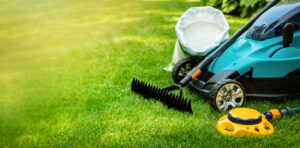A lush, green lawn adds beauty and value to a property. Proper watering, mowing, and fertilization can help to promote healthy grass that naturally crowds out weeds and pests.
Water deeply and infrequently, allowing the soil to dry slightly between irrigation sessions. Early morning is the best time to water, as this minimizes evaporation. Call Lawn Care Harrisburg PA pros today.

Spring
A lush, green lawn adds curb appeal to a home and reflects effective yard care practices. From proper soil health to mowing and fertilizing, regular aeration to overseeding and addressing pests and weeds, a yard needs attention throughout the year to thrive. Adapting lawn maintenance practices to each season promotes the health of the yard and helps avoid costly problems that can arise without consistent efforts.
In the spring, focus on gentle lawn rejuvenation by raking and applying a light layer of compost to nourish the soil. Aerate the lawn and dethatch to improve air and water circulation, which is essential to healthy root growth. Also, overseed bare spots to help the grass grow back quickly and prevent weeds from growing in these areas.
During the summer, watering is most important, as grass requires adequate moisture to thrive. When possible, water in the early morning to minimize evaporation and support deep, healthy root systems. Avoid mowing the grass too short, as this stresses the plant and can increase susceptibility to drought.
To help control the spread of weeds, consider using an herbicide designed specifically for lawns. Be sure to follow product instructions and apply as directed. Regular monitoring of your yard for weeds, insect damage and thinning grass can help you identify any potential issues as they occur and respond quickly to keep them in check.
Fall is a time to prepare for the winter, as the grass enters dormancy and requires less attention. Limit foot traffic on the lawn to minimize soil compaction and protect the grass from damage. Limiting lawn activity and managing snow and holiday decorations can also ensure that the lawn maintains its health through the winter months.
To promote healthy grass throughout the year, fertilization is vital to providing the nutrients needed for a lush, vibrant yard. The right fertilizer can enhance the color and strength of your grass, but it is important to plan your fertilization schedule based on your specific grass type and seasonal needs. Regular aeration and dethatching are essential maintenance tasks that improve grass access to air, water and nutrients and alleviate soil compaction.
Summer
During the summer, lawns require regular care to maintain their vibrant beauty. This includes watering, mowing, and fertilization in addition to routine dethatching, aeration, pest control, and overseeding. Watering is done on a regular schedule, based on weather conditions and soil moisture content. Mulching is another great practice that retains soil moisture and keeps roots cool. A healthy lawn also requires an appropriate fertilization program, based on the results of a soil test that determines pH and nutrient deficiencies.
In spring, clearing debris and removing weeds is important to allow grass to access sunlight and improve air circulation. Keeping a grass yard free of dead leaves, twigs, and other debris reduces the risk of disease and fungus. Edging the grass along sidewalks, driveways, and other structures is also a good idea for neat appearances.
Regular mowing at the correct height for the specific grass type promotes growth and prevents weed infestations. Mowing should be done on a weekly basis during peak seasons, but less frequently in drought conditions. A high-nitrogen fertiliser is recommended to promote vigorous growth and discourage weeds.
Over time, a layer of organic material called thatch may build up on the surface of the soil. This impedes water infiltration and air circulation, which is why it’s crucial to regularly dethatch your lawn. Aeration perforates the soil with small holes to alleviate compaction and allow water, nutrients, and air to reach the roots of your grass.
Pests can be a significant problem in any yard. Monitoring for signs of damage, such as bare spots, is important, especially in hot and dry summer months. Control strategies that incorporate cultural, biological, and chemical controls are the most effective for minimizing pest populations.
As the weather cools, seeding bare spots is an excellent way to restore and strengthen grass growth. A high-nitrogen fertilizer is advisable, as it will help the grass recover from stress and prepare for the transition to cooler temperatures. In late fall, a light application of slow-release fertilizer can be applied as the final step to prepare your yard for winter.
Fall
Creating and maintaining a lush, green organic lawn requires consistent care throughout the year. Each season brings its own unique challenges and opportunities for nurturing the grass, helping it recover from stress, thrive come spring, and set a strong foundation for the future. With a bit of time and effort, homeowners can take the steps needed to achieve a healthy yard for all seasons.
As summer fades into fall, focus on gentle rejuvenation by lightly raking the yard and applying a layer of compost. Overseed any bare patches and apply corn gluten meal to prevent weed germination. Adjust mowing routines to the changing grass growth rate by gradually lowering the blade, making sure to avoid cutting more than one-third of the grass height at any given time to reduce disease risk.
Aerating is essential for any lawn, but especially important in the fall when the soil becomes compacted due to increased foot traffic and rain. This process perforates the soil with small holes, alleviating compaction and allowing air, water, and nutrients to reach the roots more effectively. Dethatching is another fall lawn maintenance practice that removes a layer of dead grass and roots from the soil surface, improving water flow and nutrient absorption.
Weeds continue to be a major problem in most yards, and addressing them is an ongoing task that should be undertaken using targeted weed control methods. Regular monitoring is crucial, as even a single infestation can undermine all the hard work you’ve put into your lawn. Look out for telltale signs of a weed problem, such as patchy areas of the lawn that don’t grow or that turn brown and dry.
Fall lawn maintenance also includes a last round of fertilization, helping the grass recover from summer stress and prepare for winter. Finally, a thorough raking and cleanup of the yard is essential to minimize moisture trapping that can promote fungal problems next year. By implementing these seasonal practices, homeowners can enjoy an envy-worthy yard all year round.
Winter
The lawn is the crowning glory of a home’s outdoor space and can add significant value to your property. However, a lush green lawn requires more than occasional mowing and watering. To ensure your lawn’s health and beauty, it must be regularly watered, mowed at the proper height for your grass type, fertilized and aerated. Proper lawn care also helps prevent weed infestation, combats pests and improves soil conditions. By following these essential lawn care tips, you can achieve a beautiful and healthy yard year-round.
The first step to a healthy lawn is identifying common weeds and pests and using effective control measures. Weeds can quickly suffocate healthy turf and detract from the overall appearance of your lawn, while pests like grubs, chinch bugs, and aphids can destroy your lawn’s foliage and root system. Keeping an eye out for weeds and pests is crucial to your lawn’s health, and it can help you develop an early treatment program to protect your lawn from invasive species.
Proper lawn maintenance includes pre-emergent weed killers in spring and regular mowing to maintain appropriate grass height. Weeds can quickly overtake a lawn, so it’s important to control them with herbicide treatments and mowing practices that promote thick, dense grass, which naturally crowds out weeds.
In addition, a lawn needs regular aeration to improve air and water circulation. Aerating is especially important in fall, just before your area’s first frost date. This process loosens up thatch, increases organic matter in the soil and improves root growth.
After aerating and dethatching, spread a 1/4- to 1/2-inch layer of topsoil or compost over your entire lawn. This improves the quality of the soil, reduces thatch and provides nutrients to your lawn for its recovery during winter.
Lastly, be sure to rake or blow away any leaves or debris from your lawn. This allows for adequate light penetration and prevents snow mold or other fungus issues in the spring. Similarly, don’t leave lawn furniture, hoses, sprinklers or other equipment on your lawn over the winter. Doing so may suffocate the grass or allow pests to hide in and damage it in the spring.



